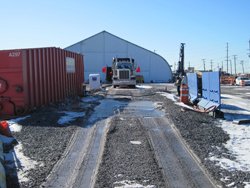
Weekly Update: February 08 - February 12, 2010
 Truck Decontamination and Scale area
|
National Grid’s Remediation Contractor continued with site remediation activities, which included the delivery of construction materials, imported backfill material (stone and common fill), and construction equipment and supplies. Shallow Excavation Area remedial activities were completed at Tent Position #14 with off-site transport and disposal of impacted soils at approved and permitted disposal facilities. Placement of imported clean backfill material and compaction was completed within the Tent Position #14 Shallow Excavation Area. National Grid’s consulting engineer conducted noise and vibration monitoring activities, as necessary.
Maintenance of the decontamination areas, work zones, on-site gravel access roads, parking areas and material staging areas, the imported backfill material (i.e., clean fill) stockpile covers, the perimeter privacy screen, and soil erosion and sediment control (SESC) measures continued. Odor and dust suppression activities were conducted, as necessary. National Grid’s consulting engineers continued to monitor the site activities with the fixed base community air monitoring program (CAMP) equipment.
During the period from February 8, 2010 through February 14, 2010, six fixed base CAMP units and one portable CAMP unit were in-use and measured total volatile organic compounds (TVOC) and particulates (PM10). Fifteen-minute averages for both TVOC and PM10 data remained in the Operational Condition. There were no elevated readings for TVOC or PM10 for the monitoring period. The Weekly Report that summarizes the CAMP data can be found as a separate tab in the Weekly Report Archive section.
For the week of February 15, 2010 through February 19, 2010, Temporary sheet piling is scheduled for removal from the former Tent Position #14 and re-driven at the next tent position. Tent relocation activities from Tent Position #14 east-northeast to the next Tent Position are scheduled for completion. Tent relocation activities will include the temporary disassembly and staging of tent anchors and the vapor management system (VMS), temporary removal of the central panel, end panels and access doors, followed by the relocation of the two tent sections and replacement of the central panel, access doors, and end panels. The temporary fabric enclosure supports, tent anchors, and VMS will be reset as the final phase of the tent position relocation. Odor and dust suppression activities will be conducted as necessary. The NYSDEC-approved supplemental dust control measure, SoilTacTM, will be placed on non-traffic areas of the site, as necessary. Work zone delineation, site maintenance activities, and CAMP operation monitoring activities will continue.